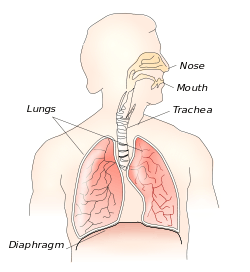Muscles of respiration
| Muscles of respiration | |
|---|---|
 Respiratory system | |
The muscles of respiration are those muscles that contribute to inhalation and exhalation, by aiding in the expansion and contraction of the thoracic cavity. The diaphragm and, to a lesser extent, the intercostal muscles drive respiration during quiet breathing. Additional 'accessory muscles of respiration' are typically only used under conditions of high metabolic demand (e.g. exercise) or respiratory dysfunction (e.g. an asthma attack).
Diaphragm
The diaphragm is the major muscle responsible for breathing. It is a thin, dome-shaped muscle that separates the abdominal cavity from the thoracic cavity. During inhalation, the diaphragm contracts, so that its centre moves caudally (downward) and its edges move rostrally (upward). This compresses the abdominal cavity, raises the ribs upward and outward and thus expands the thoracic cavity. This expansion draws air into the lungs. When the diaphragm relaxes, elastic recoil of the thoracic wall causes the thoracic cavity to contract, forcing air out of the lungs.[1]
The diaphragm is also involved in non-respiratory functions, helping to expel vomit, faeces, and urine from the body by increasing intra-abdominal pressure, and preventing acid reflux by exerting pressure on the esophagus as it passes through the esophageal hiatus.
Intercostal muscles
Along with the diaphragm, the intercostal muscles are one of the most important groups of respiratory muscles. These muscles are attached between the ribs and are important in manipulating the width of the rib cage. There are three layers of intercostal muscles. The external intercostal muscles are most significant in respiration. These have fibres that are angled obliquely downward and forward from rib to rib.[2] The contraction of these fibres raises each rib toward the rib above, with the overall effect of raising the rib cage, assisting in inhalation.
Accessory muscles of respiration
"Accessory muscles" refers to muscles that assist, but do not play a primary role, in breathing. There is some controversy concerning which muscles may be considered accessory muscles of inhalation. However, the sternocleidomastoid and the scalene muscles (anterior, middle and posterior scalene) are typically considered accessory muscles of breathing. Both assist in elevating the rib cage.[3] The involvement of these muscles seems to depend on the degree of respiratory effort. During quiet breathing, the scalenes are consistently phasically active, while the sternocleidomastoids are quiet.[4] With an increase in the respiratory volume, sternocleidomastoids also become active.[5] Both muscles are simultaneously activated when one breathes in at the maximal flow rate.[4]
Apart from the above neck muscles, the following muscles have also been observed contributing to respiration: serratus anterior, pectoralis major and pectoralis minor, trapezius, latissimus dorsi, erector spinae, iliocostalis lumborum, quadratus lumborum, serratus posterior superior, serratus posterior inferior, levatores costarum, transversus thoracis, subclavius (Kendall et al., 2005).
Use of the accessory muscles while at rest is often interpreted as a sign of respiratory distress.[6]
Muscles of exhalation
During quiet breathing, there is little or no muscle contraction involved in exhalation; this process is simply driven by the elastic recoil of the thoracic wall. When forceful exhalation is required, or when the elasticity of the lungs is reduced (as in emphysema), active exhalation can be achieved by contraction of the abdominal wall muscles (rectus abdominis, transverse abdominis, external oblique muscle and internal oblique muscle). These press the abdominal organs cranially (upward) into the diaphragm, reducing the volume of the thoracic cavity.[1]
The internal intercostal muscles have fibres that are angled obliquely downward and backward from rib to rib.[2] These muscles can therefore assist in lowering the rib cage, adding force to exhalation.[1]
References
- 1 2 3 Ratnovsky, Anat (2008). "Mechanics of respiratory muscles". Respiratory Physiology and Neurobiology. 163: 82–89. PMID 18583200. doi:10.1016/j.resp.2008.04.019.
- 1 2 Kim E. Barrett; Susan M. Barman; Scott Boitano; Heddwen Brooks (24 July 2009). "35. Pulmonary Function". Ganong's Review of Medical Physiology, 23rd Edition. McGraw-Hill Companies,Incorporated. ISBN 978-0-07-160567-0.
- ↑ Netter FH. Atlas of Human Anatomy 3rd ed. Icon Learning Systems. Teterboro, New Jersey 2003 - plate 191
- 1 2 Raper, A. J., Thompson, W. T., Shapiro, W., & Patterson, J. L. (1966). Scalene and sternomastoid muscle function. Journal of Applied Physiology, 21, 497-502.
- ↑ Campbell, E. J. M. (1955). The role of the scalene and sternomastoid muscles in breathing in normal subjects. An electromyographic study. Journal of Anatomy, 89, 378.
- ↑ Bass, Pat. "Signs of Respiratory Distress in Children". University of Rochester Medical Center. Retrieved 11 May 2015.
Further reading
- Kendall, F., McCreary, E., Provance, P., Rodgers, M., Romai, W. (2005). Muscles testing and function with posture and pain (5th ed.). PA, USA: Lippincott Williams & Wilkins.